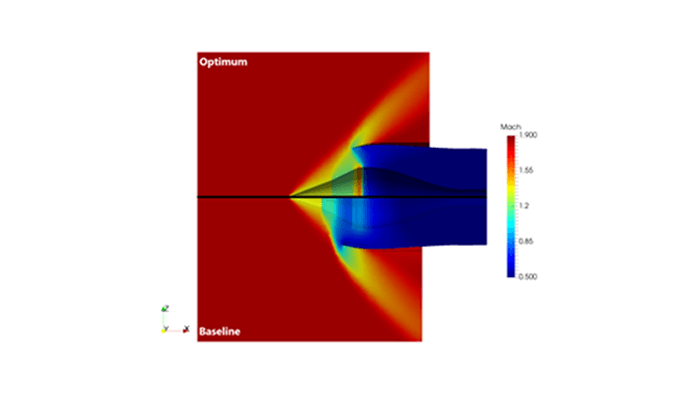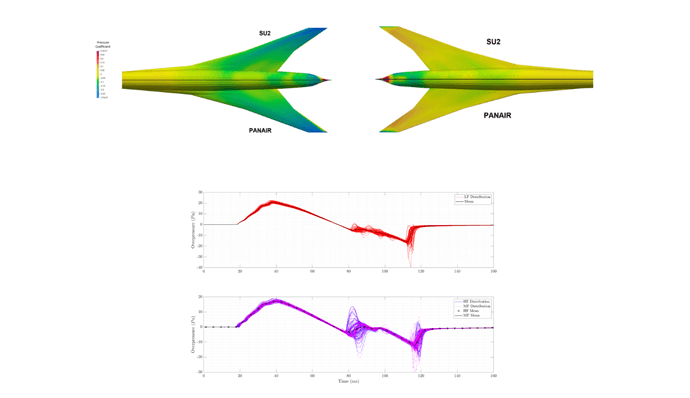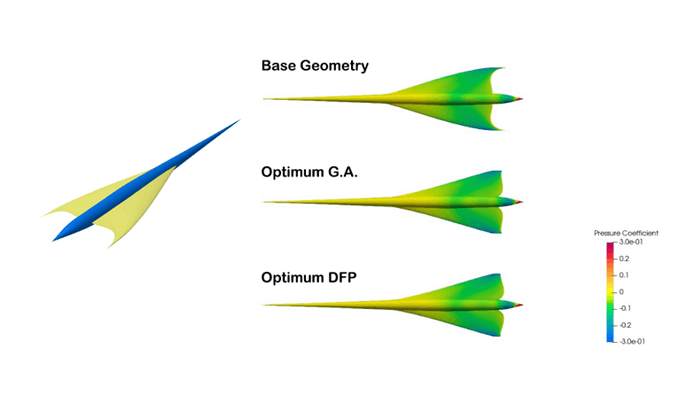1. Abstract
One of the current challenges for civil aeronautical transportation is the development of a supersonic vehicle that is both economically and environmentally feasible. In USA, since 1973, supersonic flights over populated areas have been prohibited due to the disturbances caused by sonic boom. A sonic boom is the pressure disturbance felt on the ground, caused by the shock waves propagating from the aircraft through the atmosphere to the ground when flying at supersonic speeds. An environmentally acceptable civil supersonic transport could potentially revolutionize the next phase of air transportation if reliability, economic feasibility and long range can be successfully demonstrated.
Research concerned with understanding the principles of sonic boom and the methodologies to predict and minimize sonic boom has been conducted since the 1960s. Currently, NASA’s Commercial Supersonic Technology (CST) Project is focusing on designing supersonic vehicles to overcome technical barriers to practical commercial supersonic flight such as sonic boom, fuel efficiency, airport community noise, high-altitude emissions, structural weight and flexibility, and airspace operations. The ability to design such vehicles in an integrated and multidisciplinary manner is key to addressing these challenges.
Recently, during the advanced sonic boom studies around the world, scientists focus on integrating the impact of aeroelastic deformations, the impact of propulsion system operation conditions and the impact of the optimum positioning of the engine to the overall sonic boom of a supersonic aircraft. Meanwhile, the development of the computational power and capabilities enable development of the analysis framework by including the stochastic approaches to propagate the system uncertainties, to accomplish sonic boom analysis both in conceptual and high-fidelity level, to benefit from multi-fidelity analyses and to automatically drive the multidisciplinary optimization processes.
Within the content above, the objective of this project is to develop a scientific framework in Turkey for the topic of sonic boom minimization which is regarded as a state of the art research focus in aeronautics, today. To succeed this objective, in-house codes and methodologies are developed, open-source codes are adapted and integrated with in- house interfaces, then the challenging tasks of sonic boom computation and minimization studies are carried out by considering the rigid structures, the impact of aeroelastic and propulsive coupling and also the uncertainties related to these disciplines. As an innovative contribution of this project, advanced numerical components such as computational fluid dynamics, numerical aerodynamics, linear and non-linear aeroacoustics, uncertainty quantification, multi-fidelity and multi-disciplinary optimization will be coupled in a unique computational framework to enhance the supersonic aircraft technology.
1.1. Computational Fluid Dynamics
The flow problems that are studied in this project include shock waves and resulting sonic booms. Here, the open-source SU2 computational fluid dynamics (CFD) solver is used to solve the flow around an aircraft under supersonic conditions with different numerical schemes, boundary conditions, discretization schemes, dissipation schemes and explicit time integration methods. It is expected that the utilized analysis set-up uses the available physical models in the most efficient and most accurate way. In order to speed up the solution of the problem, high performance parallel computing method supported by SU2 modules is employed where Message Transfer Interfaces (MPI) are used to perform parallel computation. High-performance parallel computing is performed by distributing the transactions made with the Message Transfer Interface among the cores provided by the central processing unit. In this way, the time taken as a result of the operations to be performed is considerably reduced depending on the number of cores. Thus, flow domains can be discretized with higher resolution grids and more accurate flow fields are obtained with an increased accuracy. The established CFD analysis infrastructure has been verified from the literature with Seeb-ALR, Delta Wing, JAXA Wing Body and C25D supersonic aircraft geometries as shown.

Figure-1: (left) Mach number distribution of the Seeb-ALR geometry in the symmetry plane. (right) Mach number distribution on the DW surface.

Figure-2: (left) Mach number distribution on the JAXA Wing Body. (right) Mach number distribution of the Seeb-ALR geometry in the symmetry plane.
1.2. Sonic Boom Prediction
Post-processing the flow field around the aircraft using high and low fidelity methods, the near-field pressure signature on a line below the two or three body lengths away from the aircraft is generated from this solution. The propagation of this near-field pressure signature in the atmosphere, which is formed by using acoustic methods, is predicted and the noise level perceived at the ground is calculated. Sonic boom waves in the atmosphere are affected by wind, relative humidity and temperature profiles. Therefore, these effects are also considered during the calculations. In this context, a computer program based on linear theories has been developed and the sBOOM nonlinear sonic boom program developed at NASA Langley Research Center is also employed in the project. In addition, an in-house non-linear sonic boom analysis program is being currently developed.

Figure-3: Representation of oblique shocks with mach number distribution.
1.3. Fluid-Structure Interactions
Fluid-structure interaction (FSI) is a multi-physics coupling between the laws that describe fluid dynamics and structural mechanics. When a fluid encounters a structure in a flow field, the aerodynamic loads by the flow exert stress and strain on the structure. Stress and strain can lead to deformations. These deformations can be quite large or very small, depending on the pressure and velocity of the flow and the material properties of the structure. Once large deformations occur, the flow conditions leading to the deformation will also be affected, causing oscillations in the fluid-structure interaction. Structures as airplane wings, turbine blades, and bridges that operate in a high-speed flow regime can suffer structural damage under these oscillations. Multi-physics problems, such as fluid-structure interaction, are too complex to be solved analytically. Therefore, similar problems are analyzed by numerical methods or experimental methods. In this project, a numerical solution is performed using SU2 fluid-structure interaction solver. The results are validated by the experimental wing tip displacement results of the HIRENASD from the literature.

Figure-4: Total deformations for the HIRENASD wing.
1.4. Engine-Airframe Integration
In supersonic aircraft design, the inclusion of realistic boundary conditions (inlet and outlet conditions) of engine operation in optimum engine-frame integration into aerodynamic, thermal and sonic boom analyzes significantly affects flow and shock waves in both rigid and aeroelastic numerical solutions. Almost all commercial and military supersonic aircraft use the turbofan engine configuration. Turbofan engine configuration works with the principle of subsonic combustion. In order for the turbofan engine to operate in a supersonic flight, the compressed air must be slowed down to subsonic speeds before entering the compressor. For this reason, supersonic air intakes are of great importance. Supersonic air intakes are designed with two different methods; with and without diverter. The purpose of using the diverter is to isolate and minimize the air entering the supersonic chamber from the effects of the boundary layer. For both designs, shock formation is observed due to the entry of the air into a narrow tunnel which increases the pressure and considerably decreases in the flow velocity. As the shock occurring in front of the air intake falls on other elements of the fuselage, the performance of the engine and control surfaces may decrease due to the increase in drag of the vertical and horizontal tails. For a low boom aircraft, each shock on the fuselage affects both the flight performance and the noise produced by the aircraft; thus, engine-body integration must be considered during the early design phase. In this project, we investigate the influence of engine installation on the sonic boom loudness for both rigid and aeroelastic engine-wing layout configurations employing SU2 multi-physics solver.

Figure-5: Different engine-wing layout configurations on the C25D.

Figure-6: Pressure coefficient of Delta Wing (DW) model with/without engine running.
1.5. Multi-fidelity, Multi-disciplinary Optimization and Uncertainty Quantification
Optimization algorithms are employed to either minimize or maximize the objective function that is subjected to con- straints on design variables and responses to achieve the best design. The goal of this study is to minimize the sonic boom loudness of a supersonic passenger aircraft by coupling multiple disciplines such as aerodynamics, structure and propulsion into the design process. However, each discipline and variable considered adds computational cost. It is extremely time consuming to use high-fidelity analysis methods (i.e. computational fluid dynamics and computational structural dynamics solvers) in processes that require numerous function evaluations such as optimization and multi- variate uncertainty analysis. Therefore, multi-fidelity analysis methods are beneficial, in which high and low accuracy analysis methods are merged together in order to keep the analysis time and cost at a reasonable level. Multi-fidelity surrogate modeling methods are generally obtained by correcting the low-fidelity surrogate model, which is trained with a large number of low-accuracy and computationally cheaper analysis results with a small number of high-accuracy and computationally expensive analysis results in design space. Shown by the following figure is a part of a completed super- sonic wing optimization study exploiting co-Kriging multi-fidelity surrogate model and both gradient-free evolutionary genetic algorithm and gradient-based Davidon-Fletcher-Powell with a multi-start scheme.

Figure-7: Multi-fidelity wing planform optimization of JAXA Wing Body with gradient-free genetic and gradient-based DFP algorithms.
Uncertainty quantification is an analysis method in which variables whose exact value is not exactly known that are included in the design process. In this project, the effects of unknown aerodynamic, structural and acoustic variables on the sonic boom noise of a supersonic passenger aircraft are investigated. In order to estimate the uncertainty in the sonic boom loudness value within a certain confidence interval, millions of analysis results are required. Therefore, it is not affordable to use high-fidelity analysis methods. In this study, as in the optimization process, uncertainty analyzes are performed using multi-fidelity methods to minimize the computational cost. Within the scope of the project, a multidisciplinary multi-fidelity uncertainty quantification is completed on the C25D aircraft using multi-fidelity polynomial chaos expansion and multi-fidelity Monte Carlo considering the angle of attack, Mach number, reflection factor, and ground elevation as random variables. The effect of aerodynamic, structural and acoustic uncertainties on the sonic boom noise of the C25D aircraft is given as a probabilistic distribution.

Figure-8: Effect of uncertain variables on wingtip displacement of C25D aircraft.

Figure-9: Probabilistic distribution of the sonic boom loudness of C25D aircraft.
Related Publications

Reliability Based Design Optimization of a Supersonic Engine Inlet
2021 AIAA Propulsion and Energy Forum
Implementation of Multidisciplinary MultiFidelity Uncertainty Quantification Methods in Sonic Boom Prediction
2021 AIAA Aviation Forum and Exposition